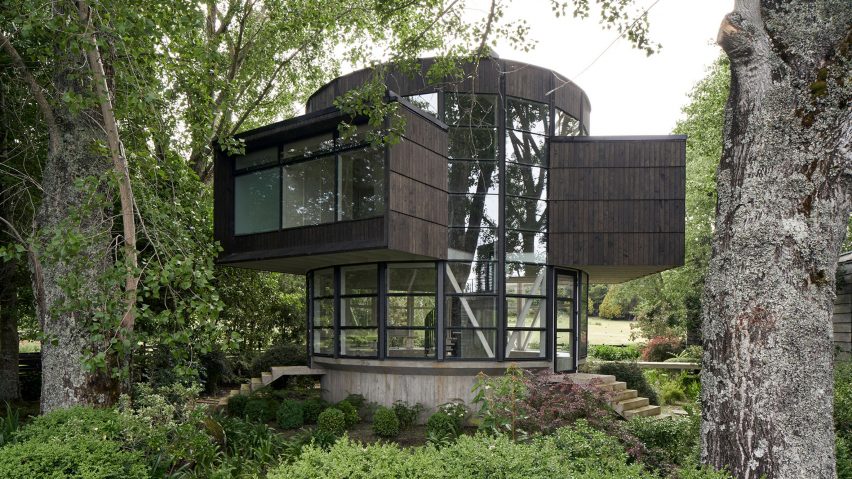Izquierdo Lehmann has designed a round lakeside house near Lago Ranco in southern Chile that is wrapped in glass with a series of wood-clad boxes projecting from its sides.
Cristián Izquierdo L, a partner at Santiago-based studio Izquierdo Lehmann, designed Casa Encoique in 2021 as a guest pavilion adjacent to an existing holiday home that would allow the site to accommodate multiple generations.
The circular glass pavilion – measuring roughly 125 square meters (1345 square feet) – is embedded in the forest and looks in every direction, and is attached to the main house via an elevated concrete walkway.
The open-plan first floor – featuring living and dining space with a small prep kitchen and 360-degree views – is round. Above, three "boxed" en-suite bedrooms are arranged in a triangle, cantilever out of the circle and are clad in pine that has been dried at 300 degrees Celsius to increase its thermal properties and longevity.
"The main challenge was to solve, in an efficient way, the triangular structure in relation to the circular base," Izquierdo said.
The upper triangular plan is rotated off-centre to reduce the length of the cantilevers and accommodate circulation space between the rooms, which contains a metal and eucalyptus spiral staircase.
"In the end, the project doesn't solve the problem – as Louis Kahn would do it in the Yale Art Center where the triangular stair meets the circle in a perfect way – but it manifests that these two orders are fighting with each other, and sometimes they fit and sometimes they don't," Izquierdo said.
The converging forms are apparent inside the bedrooms, where the box shape juts outward and the ceiling lifts up where the room connects with the circular form.
A window above the bed not only brings light into the room but holds the triangular truss that merges the box back into the curving perimeter wall.
However, modular construction methods helped to maintain a sense of cohesion on the exterior.
"While the structure of the bedrooms and the staircase make explicit the mismatches of the triangular composition, the vertical modulation of the horizontal carpentry coincides in the boxes and the glazed enclosure, masking different materials and shapes in a common module," the studio said.
The cladding, as well as the structural wooden elements, were modelled using the studio's BIM software and precut before being transferred to the remote site, allowing the construction process to be more of an assembly.
Some lines, like the horizontal joints in the exterior glazing, match perfectly to the form.
Additionally, the glass was cut into small modules for transportation to the site and ease of installation for the small on-site crew.
At night, the illuminated form becomes a lantern in the lakeside forest.
Nearby on the east side of Lago Ranco, Max-A also used modular construction to keep costs down on an angled, single-storey holiday home.
The photography is by Cristóbal Palma.
Project credits:
Architect: Cristián Izquierdo L
Collaborator: Pablo Irarrazaval
Structural engineering: FHS (Ernesto Hernández)
Constructor: Constructora Puerto Patagonia

